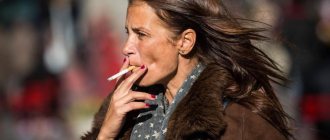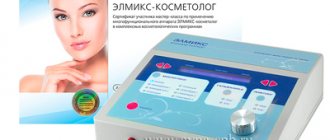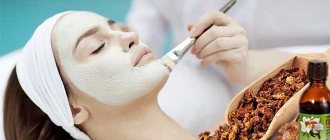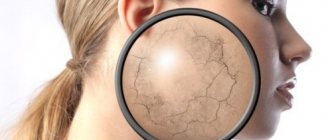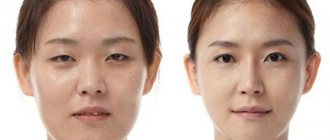Signs of age-related skin changes
Premature aging occurs at the age of 23-25 years. Even then you may notice the following symptoms:
- The skin becomes thinner and peeling appears;
- Nasolabial folds become visible;
- The first small expression wrinkles appear, especially in the area between the eyebrows and the corners of the eyes;
- The elasticity and turgor of tissues are significantly reduced.
In addition, there is swelling in the morning. Pigment spots also begin to appear.
Youth
From the age of 18, a girl’s facial features become more expressive: the folds of the eyelids are better defined, the muscles and bones of the skull become more noticeable, and the youthful softness of her features fades into the background. Lips become sensual. Until middle age, a woman’s face does not experience strong and noticeable changes. Provided that her lifestyle corresponds to a healthy one or at least close to it, but more on that later.
Changes in skin with aging
During aging, the skin undergoes the following changes:
- The epidermis becomes much thinner, which ultimately leads to the formation of wrinkles;
- The number of melanocytes in the skin increases, which provokes hyperpigmentation;
- Degenerative changes occur in the connective tissue, and the amount of adipose tissue decreases significantly. This leads to the fact that the oval of the face “floats”, the skin on the arms, stomach, and thighs sags;
- Spider veins appear on the face and lower extremities, which is a characteristic sign of fragility of the vascular bed;
- The sebaceous glands work much worse, which causes dry and vulnerable skin.
The regenerative abilities of cells also undergo changes. The skin recovers much more slowly, as a result of which wounds, cuts, and acne marks heal worse. In addition, under the influence of age-related changes in the skin, the likelihood of developing benign tumors and the formation of papillomas increases significantly.
Flat forehead
Horizontal wrinkles on the forehead are removed using botulinum therapy. But regular injections can lead to atrophy of the fat layer, and the forehead will lose volume and become completely smooth. It seems, how can a flat forehead without wrinkles age? However, it changes the entire face pattern and makes it look older.
The deficiency is eliminated by introducing fillers with hyaluronic acid. This procedure can only be entrusted to professionals, especially if you are prone to swelling. The doctor accurately determines the areas and the required volume of the drug.
Four types of facial skin aging
All people age differently - this is a fact long proven by science. Depending on a number of factors, there are 4 main types of aging:
- Tired face. The elasticity of the skin decreases significantly, swelling appears, and the nasolabial fold becomes pronounced.
- Wrinkled face. It is characterized by excessive dryness of the skin, which causes the formation of many fine wrinkles throughout the face.
- Saggy cheeks. The corners of a person’s mouth droop, the oval of the face changes significantly, jowls form, and a double chin appears.
- Eternal youth. Age-related changes may not particularly appear until the age of 40-45 - on the contrary, the face only smoothes out. However, over time, the nasolabial fold becomes pronounced.
There is also a combined type, in which all of the above signs of aging are present.
Age 55+
There is an opinion that this is the age limit when correcting one’s appearance loses its meaning. But plastic surgery itself does not oppose age to surgery: if there are no serious pathologies in the body, then there are no obstacles to plastic surgery. The final result will depend on the skill level of the specialist to whom you entrust your beauty.
Photo source: Internet
Causes for women and men
Skin aging processes are determined at the genetic level. However, there are a number of factors that can significantly accelerate age-related changes:
- Excessive skin exposure to sunlight. It has been proven that ultraviolet radiation negatively affects the condition of the dermis, causing premature aging.
- Smoking. A person poisons his body, as a result of which the skin does not receive enough nutrients and minerals and acquires a yellowish tint.
- Nutrition. Extreme diets and insufficient water intake negatively affect the condition of the skin.
- Not getting enough sleep. The optimal daily rest time is 8 hours.
- Lack of skin care. Many people ignore nourishing and moisturizing products until the signs of aging become obvious, after which completely different creams and treatments are required to restore the skin.
- Sedentary lifestyle, rare exposure to fresh air.
- Exposure to unfavorable environmental factors - dirty air, temperature changes.
- Stress. These include nerves at work, constant moral and physical stress, an unhealthy atmosphere in the family, communication with a huge number of people every day, etc.
It is noteworthy that emotionality plays a role in the appearance of the first wrinkles. If a person has active facial expressions, skin changes should be expected at an early age.
Age 15+
In most cases, surgical operations are contraindicated for adolescents and patients under 18 years of age due to the incomplete formation of the facial skeleton. The exception is otoplasty - correction of the shape of the ears.
Just recently, a few years ago, no one was interested in the problems of teenage appearance. And if a girl was bothered by pimples or protruding ears, it was believed that she needed to work on her character and self-esteem, and not think about plastic surgery.
Currently, experts recommend solving problems with appearance before school age, so as not to face pressure from society, and better yet, in early childhood. This way the ears heal faster.
Ovarian dysfunction
Ovarian dysfunction is a disruption in the functioning of the organ caused by the alternation of ovulation with anovulatory cycles, long breaks between menstruation, and then a complete attenuation of activity. This problem is faced not only by women in the premenopausal period, but also by patients of childbearing age. This is due to various factors:
- dysfunction of the thyroid gland (hypothyroidism, thyroiditis);
- inflammation of the uterus or fallopian tubes;
- STI (genital herpes, HPV);
- taking oral contraceptives;
- abortions;
- unsuccessfully placed intrauterine device;
- nicotine, alcohol, narcotic drugs;
- diseases of internal organs.
A woman should be wary of too short intervals between menstruation or long breaks between them, the absence of menstruation for several months, or spotting between menstruation. The reproductive system is affected by a brain tumor, and not necessarily a malignant one. Pituitary adenoma is often detected in women and manifests itself in the form of ovarian dysfunction.
How does an older person's appearance change?
With the onset of old age, a person's face undergoes dramatic changes. How does an older person's appearance change?
- Flabbiness of the soft tissues of the face , a clear manifestation of bone structures.
- The skin loses its elasticity, the masticatory muscles weaken , teeth fall out, which causes the cheeks to recede.
- Distinct highlighting of the cheekbones on the face.
- Moves forward and raises the chin.
- The volume of the lips decreases , they become thinner and sunken (this is especially pronounced if the front teeth are lost or worn out), and many vertical wrinkles appear on them.
- The distance from the tip of the nose to the chin becomes less and less, the location of the nasolabial folds is clearly visible.
- The oral fissure appears more compressed as the orbicularis and other labial muscles weaken, and the corners of the mouth also droop.
- The nose becomes thicker at the tip and slopes downwards, and inside it there is a massive growth of hairs; it also loses its clear outline, since by this age the cartilaginous structure has already been significantly weakened.
- Significant increase in the number of folds, wrinkles, age spots.
Change
- The temporal muscle atrophies, making the temporal region flat, sometimes sunken, with the outlines of blood vessels visible under thinned skin.
- Increased eyebrow hair stiffness and bushiness.
- Flabbiness of the upper eyelid, loss of its elasticity and acquisition of transverse wrinkles by the eyelid, reduction of the eyelid fold, which has lost the elasticity of the muscles.
- Increase in the number and length of periocular wrinkles.
- Eyelashes become sparse and shapeless.
- The appearance of bags under the lower eyelid as a result of the accumulation of fluids and fatty deposits
- Fewer fat cells remain in the eye area, so they become sunken, which changes the entire shape of the eye.
- Reduction of the pupil, due to the fact that the pigment of the iris becomes less and less, it changes color.
- The conjunctiva becomes covered with capillaries, the sclera turns yellow, and the cornea becomes increasingly dull as the content of such a component as tear fluid is minimized.
- It thickens, first turns yellow, and then the lens begins to become cloudy. Compared to an earlier age, the white of the eye becomes denser, yellowish, and gradually becomes cloudy.
- Cartilage loses its elasticity, this is especially evident in the example of the ears, which become longer, hairs begin to grow in the ear, and the lobes droop.
- You can see many wrinkles behind the ears.
- The hairline becomes thinner, and hair that has turned gray by this time begins to fall out (usually from the forehead and temples, as well as in the parietal region).
- The appearance of hair in the nasolabial triangle, possibly on the chin, after menopause.
- The totality of the above changes determines the degree of aging.
Changes in appearance
Chronic diseases of the biliary tract
Cholicystitis or chronic inflammation of the gallbladder is an inflammatory process in the gallbladder caused by infection. The mechanism of penetration of pathogenic microflora is as follows: the liver produces bile, which collects in the gallbladder. From there, it enters the duodenum through ducts, sphincters, where food is digested. If the parasympathetic nervous system malfunctions, the work of the sphincters is disrupted, and spasm of the ducts prevents bile from completely leaving the gallbladder. Bile accumulates and creates pressure inside the organ. As a result, the contents of the intestine enter the ducts, from where the infection enters the bladder, causing inflammation. Chocystitis affects 20% of the population over 30 years of age, and the disease occurs more often in women than in men. Sometimes the disease is provoked by pregnancy. A woman who does not have a problem with the gallbladder, during pregnancy or after childbirth, faces serious pathologies of the organ, sometimes requiring its removal. Exacerbation of cholecystitis in pregnant women is associated with metabolic characteristics and changes in diet during gestation. Often, pregnant women cut themselves some slack and eat everything, not only gaining excess weight, but also causing disturbances in the gastrointestinal tract. The situation is aggravated by the fact that treatment has to be postponed until after the baby is born. After 40 years, cholecystitis develops in women who are overweight; during menopause, every representative of the fair sex notices an increase in body weight, but in some cases it significantly exceeds the norm. Sometimes a woman suffers from an illness for many years, but attributes pain in the right hypochondrium, constipation and nausea to ordinary poisoning or poor diet. Timely examination helps to identify cholecystitis in the early stages, when the disease can be cured using conservative methods.
